Last year’s deadliest natural disaster wasn’t an earthquake or a flood, but a series of heat waves that roasted Europe. Between 15,000 and 24,000 people died due to extreme heat in June, July and August. London’s firefighters had their busiest day since World War II on July 19, when wildfires encroached on residential neighborhoods across the British capital.
The cost in lives would have been much higher but for action plans drawn up in the wake of 2003’s heat catastrophe, which may have killed as many as 72,000 Europeans.
As the climate changes, could a similar calamity happen in Taiwan? Are the authorities ready to protect a population that’s getting older and thus more vulnerable to extreme heat?
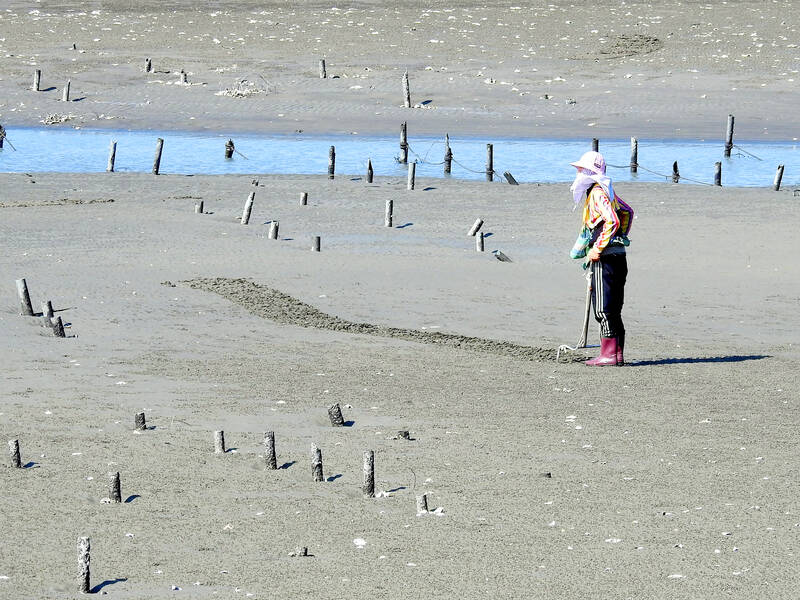
Photo: Steven Crook
HEALTH RISKS
Dehydration and heat stroke are just two of at least a dozen ways in which unusually high temperatures can kill. Many of the deaths attributable to extreme heat are due to heart or breathing problems, but broiling weather is also associated with an increase in drownings, suicides and homicides. When it’s very hot, people react more slowly, heightening the risk of accidents.
Taiwan’s summers already inflict dangerously high temperatures on the island’s human inhabitants. Wet-bulb conditions — in which a combination of heat and humidity prevents the evaporation of sweat from cooling the body — regularly occur throughout the country. When humidity exceeds 70 percent (it’s seldom lower in Taipei and Taichung) and the temperature is above 33.3 degrees Celsius, otherwise healthy people risk death if they overexert themselves.
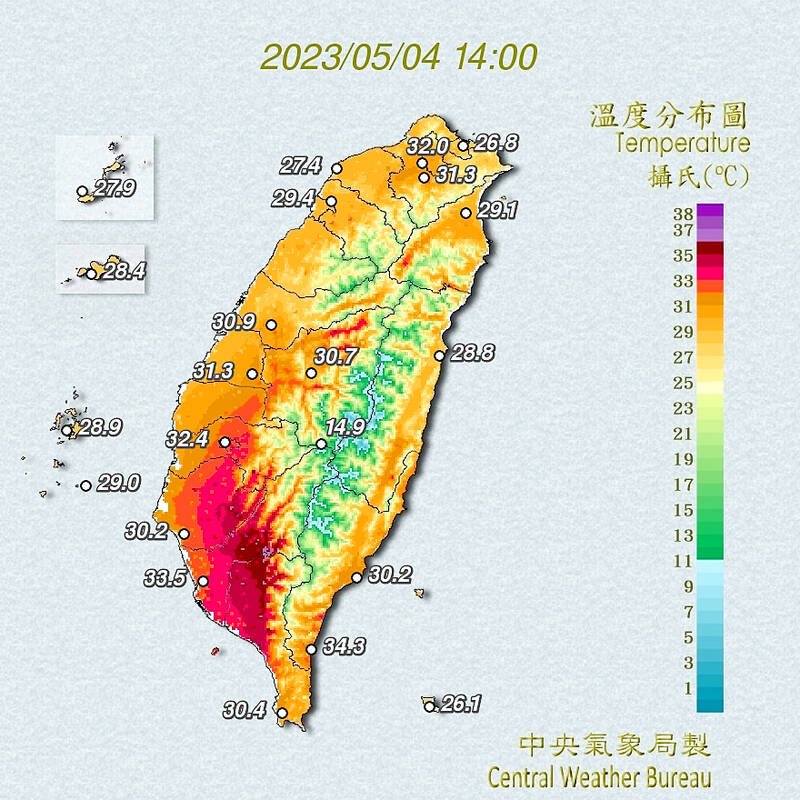
Photo courtesy of Central Weather Bureau
It’s true that most Taiwanese live and work in air-conditioned buildings, yet the prospect of elevated temperatures and more frequent and prolonged hot days is deeply worrying, and not just because there are people who can’t afford to run their air-conditioning for hours on end.
In “Extreme Weather Events and Health Responses in Taiwan,” a chapter in Extreme Weather Events and Human Health (2020), Hung Li-san (洪立三) and Li Mei-hui (李美慧) — geographers at National Taiwan Normal University and National Taiwan University (NTU), respectively — argue that several studies indicate that “the effects of dangerous heat stress on public health are expected to increase and require more attention in Taiwan.”
In addition to heat stroke and heat exhaustion, very hot weather may exacerbate health issues “in people with obesity, cardiovascular disease, respiratory disease and diabetes mellitus,” Hung and Li write.
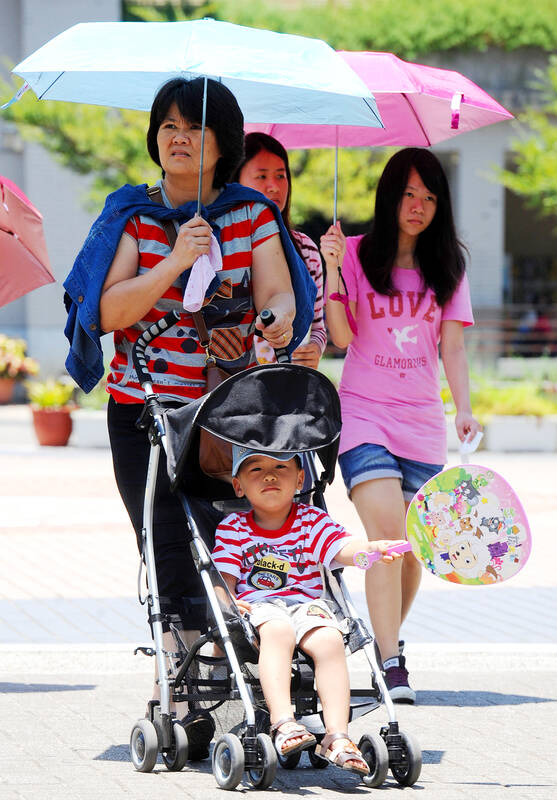
Photo: Liao Chen-huei, Taipei Times
It may surprise readers who find Taiwan’s climate uncomfortably torrid, but for one cohort, chilly weather is more dangerous than uncomfortable heat. According to Hung and Li’s review of research papers, between 1997 and 2003, “an immediate increase in cardiovascular mortality occurred after each cold surge,” with rural residents seemingly at greater risk than those in urban areas.
For those suffering from kidney disease, however, high temperatures are more likely to lead to hospital admissions than cold weather. Researchers have also found that elderly patients with respiratory disease and/or chronic airway obstruction “were vulnerable to temperatures of 30 degrees Celsius and higher, whereas younger patients associated with all types of respiratory diseases were vulnerable to temperatures of 18 degrees Celsius and below.”
Moreover, the number of outpatient visits for all respiratory diseases and asthma rose noticeably whenever a spell of extreme heat stretched beyond six days.
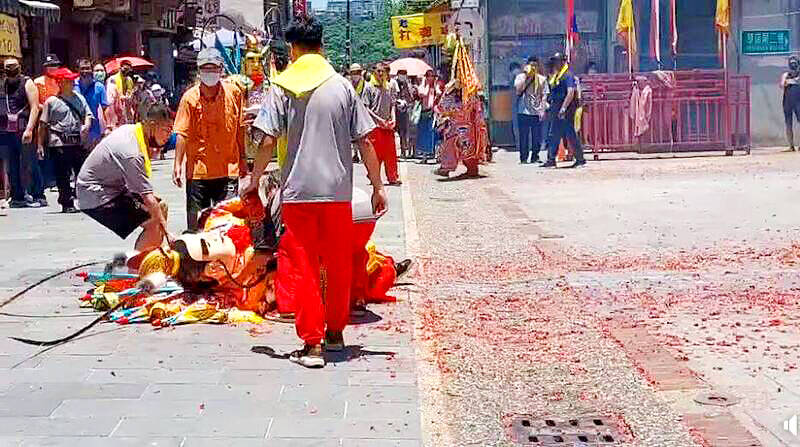
Photo courtesy of the Taiwanese Journalists Union
A 2011 study mentioned by Hung and Li concluded that the lowest overall mortality rate for elderly Taiwanese occurs around 26 degrees Celsius. Above and below this temperature, the death rate creeps upward. Central Weather Bureau (CWB) data indicates that Taipei now experiences more than 100 nights each year when temperatures stay above 25 degrees Celsius. You can be sure that, when the evening is so warm, the daytime is even hotter.
HEAT WARNINGS
On May 2 — more than two months before the peak of summer — the CWB issued a high-temperature warning for Tainan and Kaohsiung. The following day, it was extended to Pingtung.
On May 5, heat warnings applied to cities and counties holding 89 percent of the country’s population. In Tainan, Kaohsiung and Pingtung, the hazard code was upped from yellow to orange. By the following morning, the heat in the north had ebbed — but the warning for Tainan stood at red, the highest level. At Beiliao (北寮) in Tainan’s Nanhua District (南化), the mercury peaked at 40.1 degrees Celsius.
More than 1.3 million Taiwanese engage in work that may expose them to dangerously high temperatures, according to a 2009 paper by Lin Ro-ting (林若婷) of China Medical University and NTU’s Chan Chang-Chuan (詹長權).
Most of them are construction workers, but half a million are in the agriculture, forestry and fishing sectors. Cooks, bakers, people involved in the making of steel or glass, traffic police, mail carriers and others are also vulnerable between May and October.
Triennial employee surveys conducted by the Ministry of Labor’s (MOL) Institute of Labor, Occupational Safety and Health show that construction and farm workers have become more aware of the risk of excessive heat, Lin and Chan note. Among the workforce as a whole, however, the perception that high temperatures may be a health threat actually declined between 2001 and 2007. This is probably because the percentage of Taiwanese working in air-conditioned environments increased.
Men without much education are especially likely to hold jobs where heat is a common hazard. Migrant workers are another at-risk group. According to Lin and Chan, one reason why local employers recruit Southeast Asian laborers is “the notion that they have greater heat stress endurance than local workers.”
Article 6 of the Occupational Safety and Health Act (OSHA) requires employers to take steps and provide adequate equipment so as to prevent injuries, including those caused by heat. Article 19 stipulates that employees shall not work at a high-temperature site for more than six hours per day.
In an Aug. 19, 2020 Facebook post, New Power Party lawmaker Chiu Hsien-chih (邱顯智) asserted that Taiwan’s labor laws are “far from adequate” when it comes to protecting workers from high temperatures.
Highlighting Article 18 of OSHA — which gives employees a right to “terminate work of their own accord and withdraw to safe locations,” without fear of dismissal or nonpayment, if they discover “a threat of imminent danger while executing their duties” — Chiu bemoaned MOL efforts to protect laborers from extreme heat.
In 2019, MOL inspections found 1,217 violations of regulations governing work in high-temperature environments. However, Chiu complained, only one fine was imposed. In every other case, employers were merely ordered to make improvements within a set period.
“In the face of climate change and global warming, both the Ministry of Economic Affairs and the Environmental Protection Administration have mobilized. Only the MOL, like a sloth, has been sluggish,” he wrote.
For the Ministry of Health and Welfare (MOHW), extreme heat is a serious issue. Since at least 2018, the ministry has been reminding citizens and residents to stay hydrated throughout summertime, to avoid going outside during the hottest part of the day, and to pay attention to the well being of at-risk individuals, such as the obese and those on medication. Official announcements also tell the public how to recognize and treat heat injuries.
During last year’s heat crisis in Europe, elderly people living alone accounted for a striking proportion of total deaths. Even though they were typically in better health than nursing-home residents, because they lacked frequent contact with other people, no one noticed when they became confused or incapacitated, and they perished at a far higher rate.
Taiwan’s authorities need to take this on board. If they’re not already doing it, every borough chief (里長) and village chief (村長) should compile a list of local senior citizens who live by themselves, perhaps noting their general health and whether their home is likely to become an oven during the hotter months. In the next heat wave, this could well save lives.
Steven Crook, the author or co-author of four books about Taiwan, has been following environmental issues since he arrived in the country in 1991. He drives a hybrid and carries his own chopsticks. The views expressed here are his own.

Taiwan can often feel woefully behind on global trends, from fashion to food, and influences can sometimes feel like the last on the metaphorical bandwagon. In the West, suddenly every burger is being smashed and honey has become “hot” and we’re all drinking orange wine. But it took a good while for a smash burger in Taipei to come across my radar. For the uninitiated, a smash burger is, well, a normal burger patty but smashed flat. Originally, I didn’t understand. Surely the best part of a burger is the thick patty with all the juiciness of the beef, the
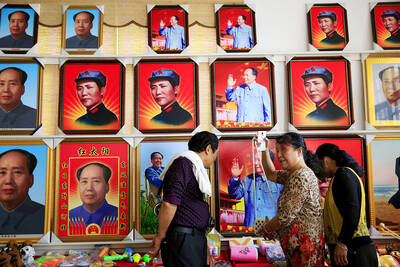
The ultimate goal of the Chinese Communist Party (CCP) is the total and overwhelming domination of everything within the sphere of what it considers China and deems as theirs. All decision-making by the CCP must be understood through that lens. Any decision made is to entrench — or ideally expand that power. They are fiercely hostile to anything that weakens or compromises their control of “China.” By design, they will stop at nothing to ensure that there is no distinction between the CCP and the Chinese nation, people, culture, civilization, religion, economy, property, military or government — they are all subsidiary

This year’s Miss Universe in Thailand has been marred by ugly drama, with allegations of an insult to a beauty queen’s intellect, a walkout by pageant contestants and a tearful tantrum by the host. More than 120 women from across the world have gathered in Thailand, vying to be crowned Miss Universe in a contest considered one of the “big four” of global beauty pageants. But the runup has been dominated by the off-stage antics of the coiffed contestants and their Thai hosts, escalating into a feminist firestorm drawing the attention of Mexico’s president. On Tuesday, Mexican delegate Fatima Bosch staged a

Nov.10 to Nov.16 As he moved a large stone that had fallen from a truck near his field, 65-year-old Lin Yuan (林淵) felt a sudden urge. He fetched his tools and began to carve. The recently retired farmer had been feeling restless after a lifetime of hard labor in Yuchi Township (魚池), Nantou County. His first piece, Stone Fairy Maiden (石仙姑), completed in 1977, was reportedly a representation of his late wife. This version of how Lin began his late-life art career is recorded in Nantou County historian Teng Hsiang-yang’s (鄧相揚) 2009 biography of him. His expressive work eventually caught the attention